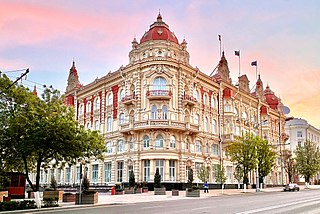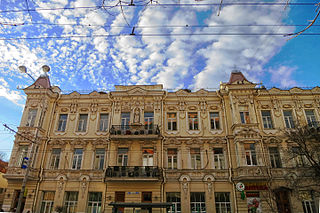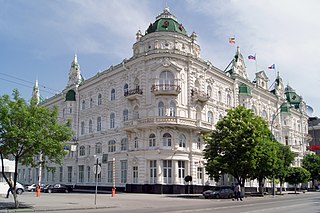
Rostov-on-Don is a port city and the administrative centre of Rostov Oblast and the Southern Federal District of Russia. It lies in the southeastern part of the East European Plain on the Don River, 32 kilometers (20 mi) from the Sea of Azov, directly north of the North Caucasus. The southwestern suburbs of the city lie above the Don river delta. Rostov-on-Don has a population of over one million people, and is an important cultural centre of Southern Russia.

Nikolai Paramonov mansion is a mansion in the city of Rostov-on-Don. It was built in 1914 for book publisher Nikolai Paramonov. The mansion was designed by architect Leonid Aeberg. The building is currently occupied by the Y.A. Zhdanov Scientific Library of Southern Federal University. The house is of Neoclassicist style and is considered to be an architectural monument of federal importance.

The Margarita Chernova House is a mansion in the city of Rostov-on-Don, Russia. It was built in 1899 by architect Nikolai Doroshenko. It has the status of an object of cultural heritage of regional importance.

Church of the Ascension of the Lord ― an Orthodox church, built in 1910-1913 on the territory of the Brethren Cemetery in Rostov-on-Don, Russia. Construction of the temple was carried out at the expense of merchants Gerasimov, Myasnikov and Safonov. The project was drafted by architect Grigory Vasilyev. The main altar was consecrated in honor of the Ascension of the Lord. Side chapels ― in honor of saints Adrian and Natalia, and in honor of St. John the Evangelist. The church has the status of an object of cultural heritage of regional significance.

Church of the Saint Queen Alexandra ― an Orthodox church in Rostov-on-Don, Russia. It was built in 1904 in the town of Nakhichevan-on-Don. The author of the project was architect Vladimir Popov. The main altar was consecrated in the name of the Saint Queen Alexandra, and northern chapel is dedicated to Saint Alexander Nevsky. Church of St. Alexandra has the status of an object of cultural heritage of regional significance.

Soldier Synagogue is the only active synagogue in Rostov-on-Don. It was built in 1872. The synagogue burnt down during the pogrom of 1905, but in 1913-1914 the building was restored. In 1935, the synagogue was closed for worship. After World War II the building was again transferred to the local Jewish community. Soldier Synagogue has the status of an object of cultural heritage of regional significance.

The Annunciation Greek Orthodox Church Russian: was a Greek Orthodox church constructed in 1909 in Rostov-on-Don. In Soviet times, the church was demolished, and the Puppet Theatre was built on its foundations. A new Greek church of the Annunciation was built close to the site of the demolished one in 2014.

Old Believers Pokrovsky Cathedral ― a cathedral of the Don and Caucasian Diocese of the Russian Orthodox Old-Rite Church, located in Rostov-on-Don. It was built in 1913 on the project of architect V.A. Pokrovsky. The cathedral has the status of an object of cultural heritage of regional significance.

Monument to Dimitry of Rostov ― is a statuary monument constructed in 1999. It is situated at the Cathedral Square in the city of Rostov-on-Don, Russia.

The Bahchisaraytsev House is a historic house in Rostov-on-Don, Russia located at the intersection of Socialist street and Budenovsky Prospekt.

The Rostov City Hall is an edifice in the Leninsky District of Rostov-on-Don, Russia. The house is located at 47 Bolshaya Sadovaya Street at the intersection of Bolshaya Sadovaya Street and Semashko lane. The building was designed in the Beaux-Arts style. It is recognized as a historical landmark, has official status as an object of Russian cultural heritage, and contains the Rostov-on-Don Administration.

The Tokarev House is an edifice in the Kirovsky District of Rostov-on-Don, Russia. The house is located at 106 Bolshaya Sadovaya street at the intersection of Chekhova avenue and Bolshaya Sadovaya street. It was a revenue house. The building is also considered to be an object of cultural heritage.

Velikanova House is a mansion and an architectural monument in the city of Rostov-on-Don, Russia. It was built in 1884—1890 on the project of architects Nikolay Doroshenko and Nikolay Sokolov. Today the building is occupied by Rostov Art College named after M.B. Grekov.

Wrangel Mansion is a building in Rostov-on-Don, built in 1885 by architect Nikolay Doroshenko. In this house Pyotr Nikolayevich Wrangel, one of the main leaders of the White Movement, spent his childhood and youth years. Wrangel Mansion has the status of an object of cultural heritage of regional significance. At present, the building is in poor condition and needs to be repaired.

Bolshaya Sadovaya Street or Big Garden Street is the main street in Rostov-on-Don. Rostov City Hall, Rostov State Musical Theater, Southern Federal University, Chernova House and other notable buildings are located on this street. The street is parallel to the Don River.

The Spielrein Mansion is a house located at 83 Pushkinskaya Street in Rostov-on-Don. It has the status of an object of cultural heritage of regional significance.

Pushkinskaya Street is one of the main streets in Rostov-on-Don. The street is named after the Russian poet Alexander Pushkin. Many old houses, university buildings and the Don State Public Library are located on this street. The Pushkinskaya Street is a green boulevard, it goes parallel to the Don River.

The Maksimov House is a building in Rostov-on-Don built in the middle of the 19th century in the neoclassical style. It is one of the oldest surviving stone buildings in the city. The first owner of the house was the merchant P. R. Maksimov. The Maksimov House has the status of an object of cultural heritage of regional significance.

The residential house of Nikolai Panin is a building in Rostov-on-Don which was built in 1910 in modernist style.

Trading house of G.G. Pustovoytov is a building in Rostov-on-Don at the intersection of Bolshaya Sadovaya and Budennovskiy avenue.



















